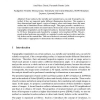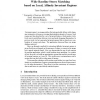CVPR
2012
IEEE
12 years 9 months ago
2012
IEEE
We present a real-time approach for image-based localization within large scenes that have been reconstructed offline using structure from motion (Sfm). From monocular video, our...
111
click to vote
BCS
2008
14 years 8 months ago
2008
: The SIFT algorithm (Scale Invariant Feature Transform) proposed by Lowe [1] is an approach for extracting distinctive invariant features from images. It has been successfully app...
CIVR
2005
Springer
15 years 3 days ago
2005
Springer
Abstract. We introduce a view–point invariant representation of moving object trajectories that can be used in video database applications. It is assumed that trajectories lie on...
ICMCS
2006
IEEE
15 years 18 days ago
2006
IEEE
In this paper, we developed a family of 2D and 3D invariant features with applications to 3D human faces recognition. The main contributions of this paper are: (a) systematically ...
GI
2007
Springer
15 years 22 days ago
2007
Springer
Abstract: Some surfaces, like metallic and varnished ones, can only be properly controlled, if they are inspected under different illumination directions. This requires a three-dim...
ICDAR
2007
IEEE
15 years 27 days ago
2007
IEEE
We describe an unsupervised learning algorithm for extracting sparse and locally shift-invariant features. We also devise a principled procedure for learning hierarchies of invari...
ICPR
2006
IEEE
15 years 7 months ago
2006
IEEE
Due to the increasing amount of 3D data for various applications there is a growing need for classification and search in such databases. As the representation of 3D objects is no...
ICIP
2004
IEEE
15 years 8 months ago
2004
IEEE
In this paper we propose an image retrieval scheme based on projectively invariant features. Since cross-ratio is the fundamental invariant feature under projective transformation...
ICCV
1998
IEEE
15 years 8 months ago
1998
IEEE
`Invariant regions' are image patches that automatically deform with changing viewpoint as to keep on covering identical physical parts of a scene. Such regions are then desc...
CVPR
2004
IEEE
15 years 8 months ago
2004
IEEE
Invariant features or operators are often used to shield the recognition process from the effect of "nuisance" parameters, such as rotations, foreshortening, or illumina...






